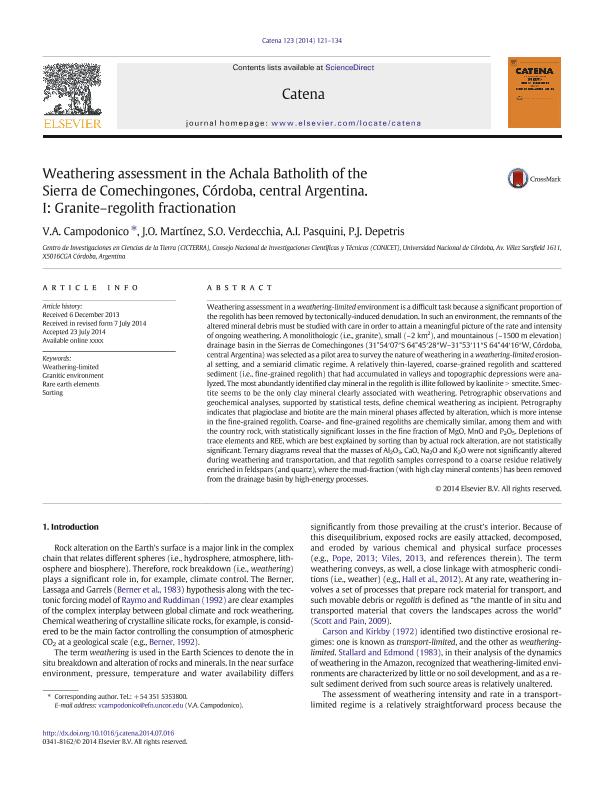Mostrar el registro sencillo del ítem
dc.contributor.author
Campodonico, Verena Agustina

dc.contributor.author
Martínez, Jorge Oscar

dc.contributor.author
Verdecchia, Sebastián Osvaldo

dc.contributor.author
Pasquini, Andrea Ines

dc.contributor.author
Depetris Gallino, Pedro Jose

dc.date.available
2018-01-03T15:09:58Z
dc.date.issued
2014-12
dc.identifier.citation
Depetris Gallino, Pedro Jose; Pasquini, Andrea Ines; Verdecchia, Sebastián Osvaldo; Martínez, Jorge Oscar; Campodonico, Verena Agustina; Weathering assessment in the Achala Batholith of the Sierra de Comechingones, Córdoba, central Argentina. I: Granite–regolith fractionation; Elsevier Science; Catena; 123; 12-2014; 121-134
dc.identifier.issn
0341-8162
dc.identifier.uri
http://hdl.handle.net/11336/32120
dc.description.abstract
Weathering assessment in a weathering-limited environment is a difficult task because a significant proportion of the regolith has been removed by tectonically-induced denudation. In such an environment, the remnants of the altered mineral debris must be studied with care in order to attain a meaningful picture of the rate and intensity of ongoing weathering. A monolithologic (i.e., granite), small (~ 2 km2), and mountainous (~ 1500 m elevation) drainage basin in the Sierras de Comechingones (31°54′07″S 64°45′28″W–31°53′11″S 64°44′16″W, Córdoba, central Argentina) was selected as a pilot area to survey the nature of weathering in a weathering-limited erosional setting, and a semiarid climatic regime. A relatively thin-layered, coarse-grained regolith and scattered sediment (i.e., fine-grained regolith) that had accumulated in valleys and topographic depressions were analyzed. The most abundantly identified clay mineral in the regolith is illite followed by kaolinite > smectite. Smectite seems to be the only clay mineral clearly associated with weathering. Petrographic observations and geochemical analyses, supported by statistical tests, define chemical weathering as incipient. Petrography indicates that plagioclase and biotite are the main mineral phases affected by alteration, which is more intense in the fine-grained regolith. Coarse- and fine-grained regoliths are chemically similar, among them and with the country rock, with statistically significant losses in the fine fraction of MgO, MnO and P2O5. Depletions of trace elements and REE, which are best explained by sorting than by actual rock alteration, are not statistically significant. Ternary diagrams reveal that the masses of Al2O3, CaO, Na2O and K2O were not significantly altered during weathering and transportation, and that regolith samples correspond to a coarse residue relatively enriched in feldspars (and quartz), where the mud-fraction (with high clay mineral contents) has been removed from the drainage basin by high-energy processes.
dc.format
application/pdf
dc.language.iso
eng
dc.publisher
Elsevier Science

dc.rights
info:eu-repo/semantics/openAccess
dc.rights.uri
https://creativecommons.org/licenses/by-nc-sa/2.5/ar/
dc.subject
Weathering-Limited
dc.subject
Granitic Environment
dc.subject
Rare Earth Elements
dc.subject
Sorting
dc.subject.classification
Meteorología y Ciencias Atmosféricas

dc.subject.classification
Ciencias de la Tierra y relacionadas con el Medio Ambiente

dc.subject.classification
CIENCIAS NATURALES Y EXACTAS

dc.title
Weathering assessment in the Achala Batholith of the Sierra de Comechingones, Córdoba, central Argentina. I: Granite–regolith fractionation
dc.type
info:eu-repo/semantics/article
dc.type
info:ar-repo/semantics/artículo
dc.type
info:eu-repo/semantics/publishedVersion
dc.date.updated
2017-12-28T18:22:44Z
dc.journal.number
123
dc.journal.pagination
121-134
dc.journal.pais
Países Bajos

dc.journal.ciudad
Amsterdam
dc.description.fil
Fil: Campodonico, Verena Agustina. Consejo Nacional de Investigaciones Científicas y Técnicas. Centro Científico Tecnológico Conicet - Córdoba. Centro de Investigaciones en Ciencias de la Tierra. Universidad Nacional de Córdoba. Facultad de Ciencias Exactas Físicas y Naturales. Centro de Investigaciones en Ciencias de la Tierra; Argentina
dc.description.fil
Fil: Martínez, Jorge Oscar. Consejo Nacional de Investigaciones Científicas y Técnicas. Centro Científico Tecnológico Conicet - Córdoba. Centro de Investigaciones en Ciencias de la Tierra. Universidad Nacional de Córdoba. Facultad de Ciencias Exactas Físicas y Naturales. Centro de Investigaciones en Ciencias de la Tierra; Argentina
dc.description.fil
Fil: Verdecchia, Sebastián Osvaldo. Consejo Nacional de Investigaciones Científicas y Técnicas. Centro Científico Tecnológico Conicet - Córdoba. Centro de Investigaciones en Ciencias de la Tierra. Universidad Nacional de Córdoba. Facultad de Ciencias Exactas Físicas y Naturales. Centro de Investigaciones en Ciencias de la Tierra; Argentina
dc.description.fil
Fil: Pasquini, Andrea Ines. Consejo Nacional de Investigaciones Científicas y Técnicas. Centro Científico Tecnológico Conicet - Córdoba. Centro de Investigaciones en Ciencias de la Tierra. Universidad Nacional de Córdoba. Facultad de Ciencias Exactas Físicas y Naturales. Centro de Investigaciones en Ciencias de la Tierra; Argentina
dc.description.fil
Fil: Depetris Gallino, Pedro Jose. Consejo Nacional de Investigaciones Científicas y Técnicas. Centro Científico Tecnológico Conicet - Córdoba. Centro de Investigaciones en Ciencias de la Tierra. Universidad Nacional de Córdoba. Facultad de Ciencias Exactas Físicas y Naturales. Centro de Investigaciones en Ciencias de la Tierra; Argentina
dc.journal.title
Catena

dc.relation.alternativeid
info:eu-repo/semantics/altIdentifier/doi/http://dx.doi.org/10.1016/j.catena.2014.07.016
dc.relation.alternativeid
info:eu-repo/semantics/altIdentifier/url/http://www.sciencedirect.com/science/article/pii/S0341816214002227
Archivos asociados
